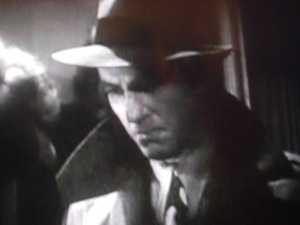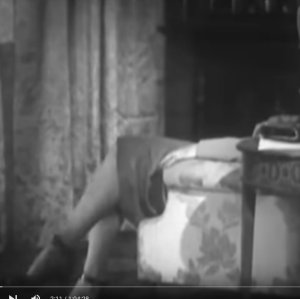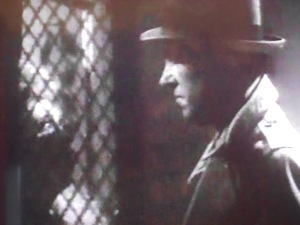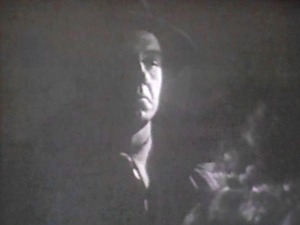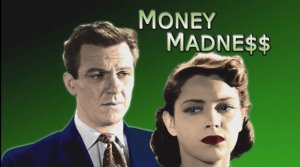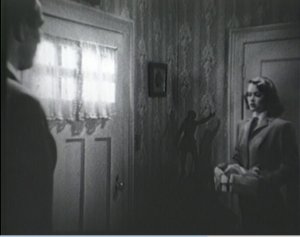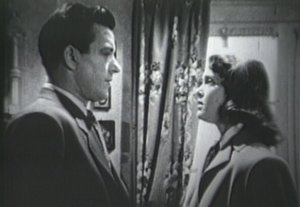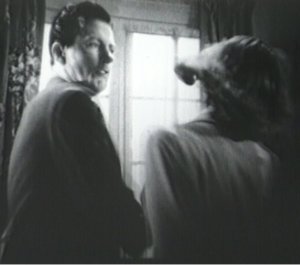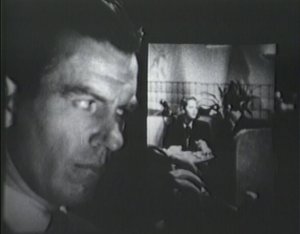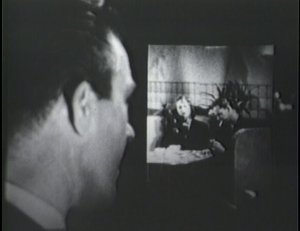People argue over who’s the toughest, grittiest, most acerbic, maybe even most psychologically damaged, of film noir anti-heroes. Is it Alan Ladd of the tight jaw and cold eyes? The coolly sarcastic and sharply violent Humphrey Bogart? Robert Mitchum, sleepy-eyed, drawling voiced, and deadly? Maybe Robert Ryan with his violent psychosis seething beneath a tautly charming exterior? How about Dick Powell and John Payne, who exchanged careers as fading singing romantic leads for playing opportunistic, quick-fisted, and switchblade-tongued types? Naaugh – The most sardonic, amoral, dark, or even psychotic of them all was, yeah, you guessed it – Hugh Beaumont!
Hugh Beaumont?!“What?!!!” you say. Wally and the Beave’s staid, gentle-humored, reasonable dad? You bet your blackjack, Baby. In the late 1940s and early ’50s, Beaumont turned in a rogues gallery of noir baddies that would have sent June Cleaver running for the hills – if Hugh let her live that long! A busy supporting player through the 1940s and ’50s, Beaumont did play his share of good guys. However, even some of them were a bit left of center. Consider the justifiably nerved up pal of John Garfield, afeard of fifth columnists in The Fallen Sparrow; The Seventh Victim’s staid and steady (ironically last-named Ward) husband of the tortured Jacqueline whose “normal” qualities made him useless to face her demons; or Army Air Force buddy of William Bendix and Alan Ladd in The Blue Dahlia, whose cool skepticism betrays a healthy dose of contempt for the Law. Still, it was the films that Beaumont made at Sig Neufeld’s Poverty Row studio PRC that were one of the best showcases of his ability to shine, or more accurately glower, as characters on the dark, even monstrous, side. Apology for Murder (1948), directed by Sam Neufield (né Neufeld, Sig’s brother), is particularly interesting. Beaumont’s amoral Kenny Blake is a smart-talking reporter whose editor Do the misadventures of the amoral, weak Kenny and his seductive paramour sound familiar? They should. Apology is a blatant rip-off of Billy Wilder’s Double Indemnity: from the tempting via sexy gams early on to the adulterers’ secret meetings and murder plans, to murder by wrench to the noggin while the camera focuses on the wife’s face to the avuncular/adversarial relationship between mentor (editor/insurance investigator) and mentee (writer/insurance salesman) to the near finale shootout and finally to mentor/mentee discovery of the crimes’ recorded history at the very 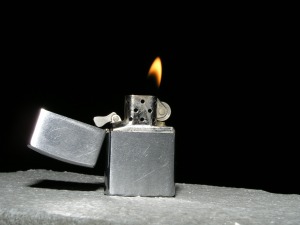 end. But the choices that Neufield and his writer Fred Myton make don’t innovate on, often only weaken, the original. Kenny make crack wise, but there is no dialogue between him and his leading lady or his mentor that comes close to the crackle of Walter Neff with Phyllis or with Barton Keyes. The tension when Phyllis gently pulls on the door that hides her to signal to Walter that he mustn’t give away her presence to Keyes standing before him dissipates into Steve hopping into the bushes by the femme’s front door when she lets out an important character. Notable switch up in this film from the original? Neufield and Myton reverse who can light a cigarette and who can’t from mentee to mentot– oh, and we move from matched to lighters. Apology for Murder isn’t a bad movie. It would just look better if there weren’t an original with which to make a comparison. Then again, without the original, there’d be no Apology, or a need for one. Still, we can clearly see why Neufield was working at PRC and Wilder was at Paramount. Two other PRC gems in Beaumont’s noir resumé reveal him as a player of not only the louche but the downright monstrous. In The Lady Confesses (1945), he’s Scot, a personable fellow happily engaged to Vicki, until his first wife shows up after having disappeared almost seven years ago. Next thing you know, the ex is found strangled with wire, Steve’s alibi of sleeping one off in a nightclub singer friend’s dressing room doesn’t convince the investigating detective, and Vicki has signed on
Money Madness must be Beaumont’s most unnerving performance. The writing and the player enacting it keep us as off-kilter as the female lead, Julie, in understanding who the real Fred Howard (aka Steve Clarke) really is. We first see Beaumont’s Howard/Clarke get off a bus a stop before he was originally ticketed, deposit some dough in a bank strong box, and grab an advertised job as a cab driver – all with the arrogant attitude of someone with a mission, but with something to hide. However, next thing we know, he’s saving Julie from a masher, wooing her with kindness and humor, and charming the possessive harridan of an aunt with whom she lives. Ah, so he’s not a bad guy after all. Maybe he’s just been misunderstood or framed for something. He marries Julie in a
To read “King of the Noir Anti-Heroes, Part 2,” click here for Beaumont’s left-side of the law detective series.-Hugh Beaumont Image from The Lady Confesses screen shot, Alpha Video public domain video (author’s collection) Background on the Neufeld’s and PRC at imdb: https://www.imdb.com/name/nm0626892/ |

